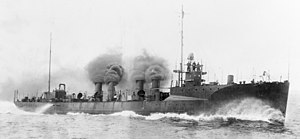
The Clemson class was a series of 156 destroyers which served with the United States Navy from after World War I through World War II.

The Wickes-class destroyers were a class of 111 destroyers built by the United States Navy in 1917–19. Along with the 6 preceding Caldwell-class and 156 subsequent Clemson-class destroyers, they formed the "flush-deck" or "four-stack" type. Only a few were completed in time to serve in World War I, including USS Wickes, the lead ship of the class.

The Beagle class was a class of sixteen destroyers of the Royal Navy, all ordered under the 1908-1909 programme and launched in 1909 and 1910. The Beagles served during World War I, particularly during the Dardanelles Campaign of 1915.
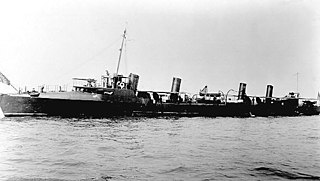
Three Truxtun-class destroyers were built for the United States Navy. Part of the original 16 destroyers authorized by Congress on 4 May 1898 for the fiscal year 1899 program, they were commissioned in 1902. They were very similar to their Bainbridge-class contemporaries, except for mounting six 6-pounder (57 mm) guns instead of five. They were considered the most successful of the first 16 US Navy destroyers, and were succeeded by the larger Smith class.

The Bainbridge-class destroyers were a class of United States Navy Torpedo Boat Destroyers (TBDs) built between 1899 and 1903. The first class so designated, they comprised the first 13 of 16 TBDs authorized by Congress in 1898 following the Spanish–American War. One ship of the class was lost at sea during service in World War I: Chauncey, which collided with the British merchant ship SS Rose in 1917. The balance were decommissioned in 1919 and sold postwar in 1920, eleven to Joseph G. Hitner of Philadelphia, and the Hopkins to the Denton Shore Lumber Company in Tampa, Florida.

The Paulding-class destroyers were a series of United States Navy destroyers derived from the Smith class with the torpedo tubes increased from three to six via twin mounts. They were the first destroyers in the US Navy with oil-fired boilers. The 21 Pauldings doubled the number of destroyers in the US Navy. The Paulding class derived its name from the class's lead ship, Paulding, named for Rear Admiral Hiram Paulding (1797–1878). Like the Smiths, they were nicknamed "flivvers" after the small and shaky Model T Ford once the larger "thousand tonner" destroyers entered service.

Four destroyers in the United States Navy comprised the Cassin class. All served as convoy escorts during World War I. The Cassins were the first of five "second-generation" 1000-ton four-stack destroyer classes that were front-line ships of the Navy until the 1930s. They were known as "thousand tonners" for their normal displacement, while the previous classes were nicknamed "flivvers" for their small size, after the Model T Ford.
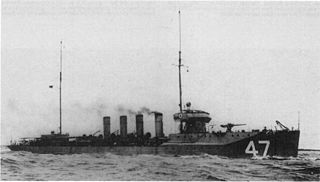
The Aylwin class was a class of four destroyers in the United States Navy; all served as convoy escorts during World War I. The Aylwins were the second of five "second-generation" 1000-ton four-stack destroyer classes that were front-line ships of the Navy until the 1920s. They were known as "thousand tonners". All were scrapped in 1935 to comply with the London Naval Treaty.
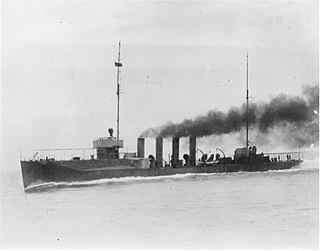
The O'Brien class of destroyers was a class of six ships designed by and built for the United States Navy shortly before the United States entered World War I. The O'Brien class was the third of five classes of destroyers that were known as the "thousand tonners", because they were the first U.S. destroyers over 1,000 long tons (1,016 t) displacement.
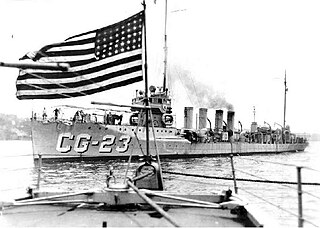
The Tucker class of destroyers was a ship class of six ships designed by and built for the United States Navy shortly before the United States entered World War I. The Tucker class was the fourth of five classes of destroyers that were known as the "thousand tonners", because they were the first U.S. destroyers over 1,000 long tons (1,016 t) displacement.

The Sampson-class destroyers served in the United States Navy during World War I. Commissioned in 1916 and 1917, the class was a modification of the O'Brien and Tucker classes, with the number of 21-inch (533 mm) torpedo tubes increased from four twin-mounts to four triple-mounts. The Sampsons were the final six ships of the 26 "thousand tonner" destroyers. They were the largest and most heavily armed of the "thousand tonners", and the subsequent "flush deck" classes differed mainly in hull design and the engineering plant.

USS Flusser (DD-289) was a Clemson-class destroyer built for the United States Navy during World War I.

The Caldwell class was a class of six "flush deck" United States Navy destroyers built during World War I and shortly after. Four served as convoy escorts in the Atlantic; the other two were completed too late for wartime service. Two were scrapped during the 1930s, but four survived to serve throughout World War II, three of these in service with the Royal Navy under the Destroyers for Bases Agreement and the fourth as a high speed transport.

The Farragut-class destroyers were a class of eight 1,365-ton destroyers in the United States Navy and the first US destroyers of post-World War I design. Their construction, along with the Porter class, was authorized by Congress on 29 April 1916, but funding was delayed considerably. Limited to 1,500 tons standard displacement by the provisions of the London Naval Treaty of 1930, the ships were laid down beginning in 1932 and were completed by 1935. After 12 years since the last of the previous class of American destroyers was commissioned, the Farraguts were commissioned in 1934 and 1935.

The Porter-class destroyers were a class of eight 1,850-ton large destroyers in the United States Navy. Like the preceding Farragut-class, their construction was authorized by Congress on 26 April 1916, but funding was delayed considerably. They were designed based on a 1,850-ton standard displacement limit imposed by the London Naval Treaty; the treaty's tonnage limit allowed 13 ships of this size, and the similar Somers class was built later to meet the limit. The first four Porters were laid down in 1933 by New York Shipbuilding in Camden, New Jersey, and the next four in 1934 at Bethlehem Steel Corporation in Quincy, Massachusetts. All were commissioned in 1936 except Winslow, which was commissioned in 1937. They were built in response to the large Fubuki-class destroyers that the Imperial Japanese Navy was building at the time and were initially designated as flotilla leaders. They served extensively in World War II, in the Pacific War, the Atlantic, and in the Americas. Porter was the class' only loss, in the Battle of the Santa Cruz Islands on 26 October 1942.

The Somers-class destroyer was a class of five 1850-ton United States Navy destroyers based on the Porter class. They were answers to the large destroyers that the Japanese navy was building at the time, and were initially intended to be flotilla leaders. They were laid down from 1935–1936 and commissioned from 1937–1939. They were built to round-out the thirteen destroyers of 1,850 tons standard displacement allowed by the tonnage limits of the London Naval Treaty, and were originally intended to be repeat Porters. However, new high-pressure, high-temperature boilers became available, allowing the use of a single stack. This combined with weight savings allowed an increase from two quadruple center-line torpedo tube mounts to three. However, the Somers class were still over-weight and top-heavy. This was the first US destroyer class to use 600 psi (4,100 kPa) steam superheated to 850 °F (454 °C), which became standard for US warships built in the late 1930s and World War II.

The 3"/50 caliber gun in United States naval gun terminology indicates the gun fired a projectile 3 inches (76 mm) in diameter, and the barrel was 50 calibers long. Different guns of this caliber were used by the U.S. Navy and U.S. Coast Guard from 1900 through to 1990 on a variety of combatant and transport ship classes.

The three Chester-class cruisers were the first United States Navy vessels to be designed and designated as fast "scout cruisers" for fleet reconnaissance. They had high speed but little armor or armament. They were authorized in January 1904, ordered in fiscal year 1905, and completed in 1908. In 1920 all scout cruisers were redesignated as "light cruisers" (CL).

The Guadiana class was a class of four destroyers employed by the Portuguese Navy between 1913 and 1942. This class is often alternatively referred as the Douro class.
